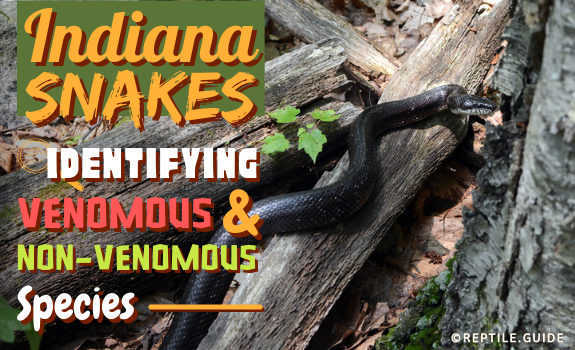There’s more than just corn in Indiana – including roughly 36 species and subspecies of Indiana snakes!
Keep reading to learn which cold-blooded serpents call this midwestern state home, including four venomous species and many unique and harmless Indiana snakes, like the Eastern Blue Racer.
We’ll also cover some identification basics, including Indiana’s snakes’ pictures, and what to do if you encounter a snake in the wild.
In This Article
In Short
- Roughly 36 types of snake live in Indiana.
- Indiana is home to four venomous snakes.
- All of Indiana’s venomous snakes are pit vipers.
- Many Indiana snake species look similar and are hard to differentiate.
- Snakes inhabit every corner of the state, from open fields to rocky glades.
Snake Identification Basics
Sometimes, the same snake species can look different depending on the state it lives in. This identification guide is for Indiana snakes only.
Here are some key features to look for when attempting to identify any wild snake:
- Size – is the snake long or short? Is its body thin or stout?
- Scales – are they rough, bumpy, sharp, smooth, or glossy?
- Pupil Shape – are they round or elliptical?
- Color and Pattern – Indiana is home to blotched, banded, patternless, and striped snakes. There are blue, green, red, brown, and black snakes in Indiana.
- Unique Characteristics – are there any distinctive features, like the upturned snout of the Eastern Hognose Snake?
Quickly Identifying Venomous Snakes in Indiana
A snake’s pattern isn’t always a reliable way to identify venomous snakes because many harmless snakes mimic the appearance of venomous snakes to deter predators.
With a bit of reptile education, differentiating pit vipers from most North American colubrids is straightforward. Look for these key characteristics:
- Broad, triangular heads
- Elliptical, cat-like pupils
- Rattle on tail (rattlesnakes only)
- Heat-sensing pits between the nostrils and eyes
Timber Rattlesnake
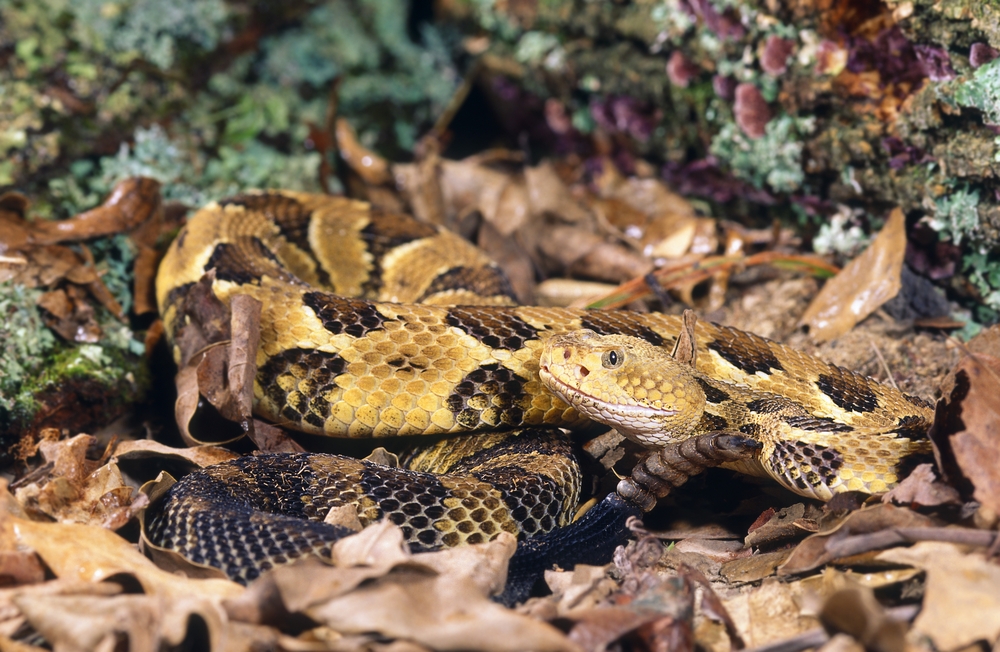
| Scientific Name: | Crotalus horridus |
|---|---|
| Range: | South-central Indiana |
| Size: | 2 – 5 ft. |
| Description: | Heavy-bodied
Rattle on tail tip Velvety black tail Spade-shaped head Heavily keeled scales Black chevron pattern, light orange-brown dorsal stripe Base color starts light brown or gray at the head, and gradually darkens to black towards the tail |
| Habitat: | Rugged deciduous and coniferous forests |
| Venomous/Non-Venomous: | Venomous |
Western Cottonmouth
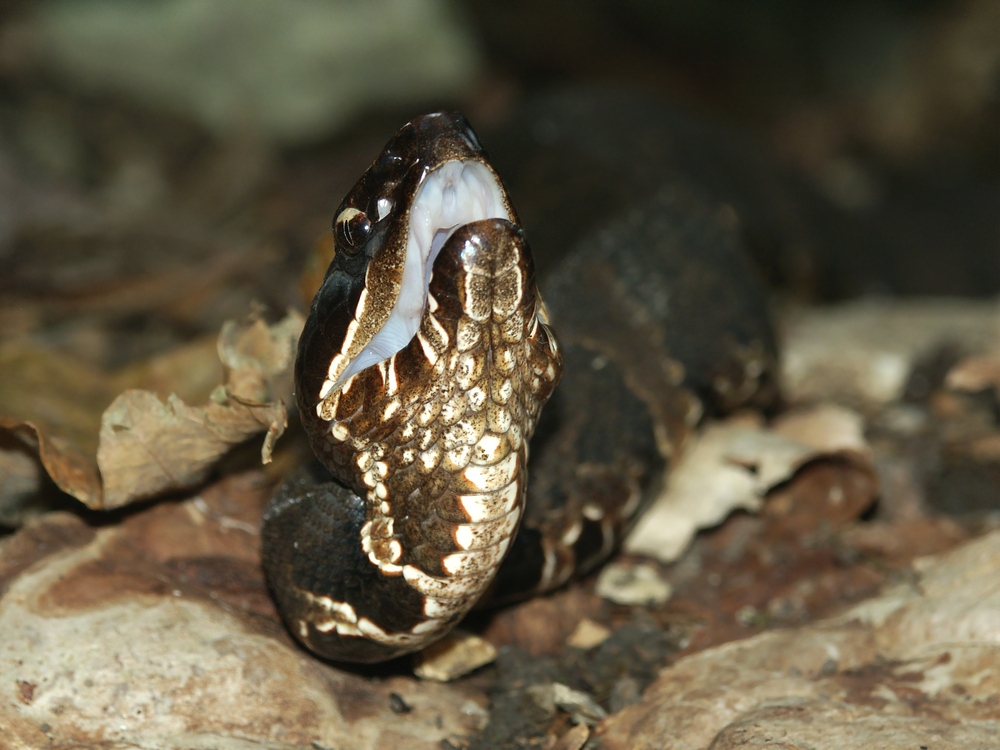
| Scientific Name: | Agkistrodon piscivorus |
|---|---|
| Range: | Southwestern corner of Indiana |
| Size: | 2 – 5 ft. |
| Description: | Keeled scales
Heavy-bodied Broad, triangular head Juveniles have a bright yellow tail tip Base color ranges from light tan to nearly black Pixelated, dark-colored lateral bands widest near the belly and narrow towards the spine
|
| Habitat: | Most wetland habitats |
| Venomous/Non-Venomous: | Venomous |
Northern Copperhead
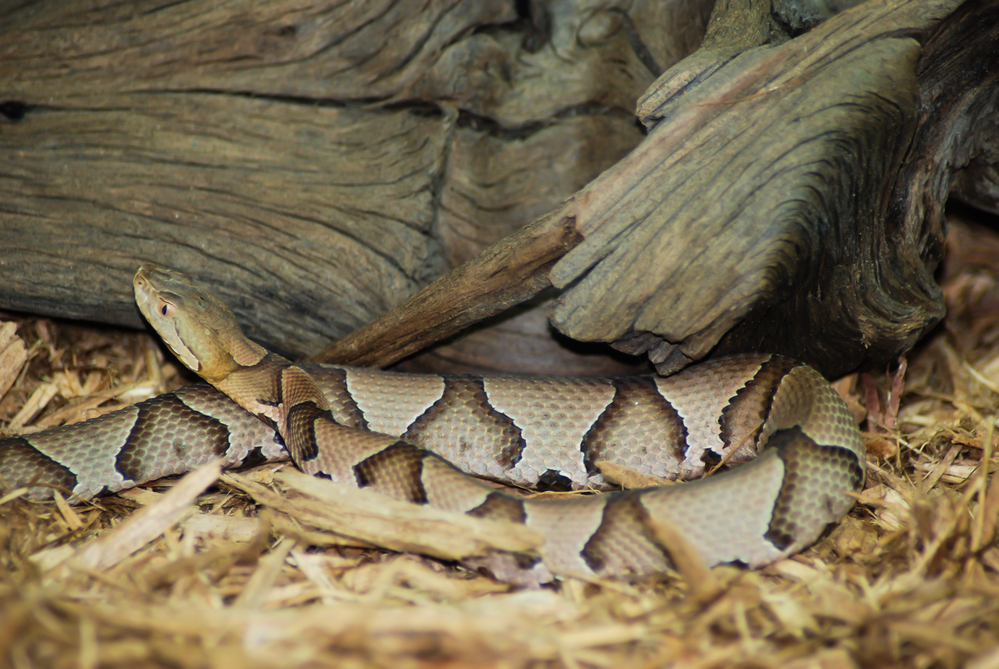
| Scientific Name: | Agkistrodon contortrix |
|---|---|
| Range: | Southern ½ of Indiana |
| Size: | 2 – 3 ft. |
| Description: | Keeled scales
Heavy-bodied Broad, triangular head Juveniles have a bright yellow tail tip Base color ranges from light gray to reddish-brown Hershey’s kiss shaped lateral pattern that’s widest at the bottom and narrow towards the spine |
| Habitat: | Elevated, dry, rocky forests |
| Venomous/Non-Venomous: | Venomous |
Eastern Massasauga Rattlesnake
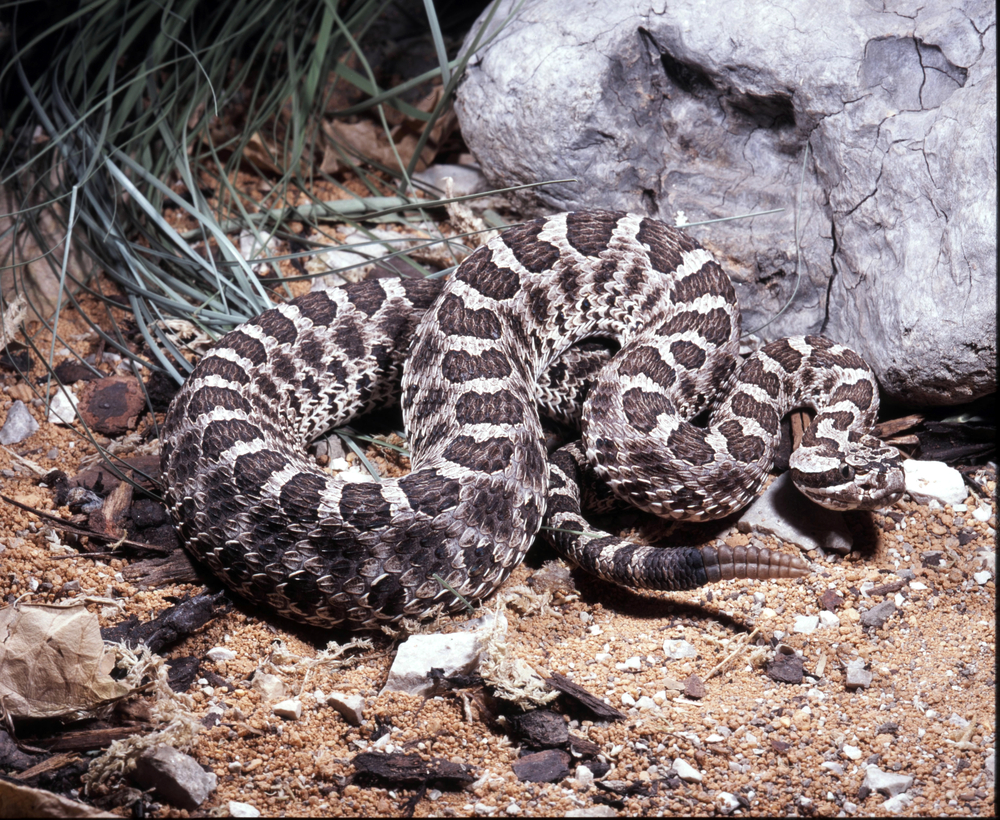
| Scientific Name: | Sistrurus catenatus |
|---|---|
| Range: | Northern ½ of Indiana |
| Size: | 24 – 30 in. |
| Description: | Keeled scales
Heavy-bodied Broad, triangular head Small rattle may be present on tail tip Base color ranges from gray to brown Broad, dark stripe along the side of the head and through the eye One row of brown dorsal blotches and three alternating rows of lateral dark blotches on each side |
| Habitat: | Most wetland habitats |
| Venomous/Non-Venomous: | Venomous |
Common Snakes in Indiana
The common snakes in Indiana that you’ll find depend on where you are in the state and the type of habitat you’re exploring.
The Eastern Garter Snake probably takes the spot for the most common species across the state.
Here’s a generalized list of the five most common types of snakes you might see across the entire state.
Milk Snakes
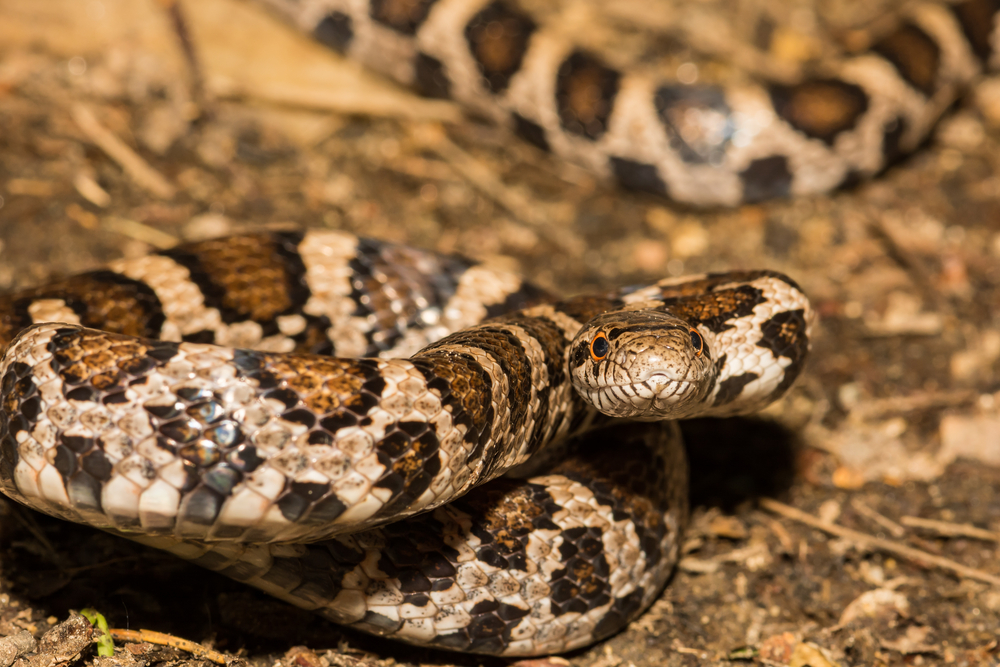
| Scientific Name: | Lampropeltis triangulum syspila (Red Milk Snake)
Lampropeltis triangulum triangulum (Eastern Milk Snake) |
|---|---|
| Range: | Statewide
L. t. syspila: Southwestern Indiana |
| Size: | 2 – 4 ft. |
| Description: | Smooth scales
Base color is gray to light brown Single row of dark brown or red dorsal blotches outlined in black Juveniles usually have bright red pattern that fades to brown with age |
| Habitat: | Edge habitats between dense forests and open grasslands |
| Venomous/Non-Venomous: | Non-Venomous |
Fun Fact: Milk snakes also make great pets! Removing snakes from the wild is unethical and may be illegal where you live; be sure to buy your pet snake from a reputable breeder.
Ribbon Snake
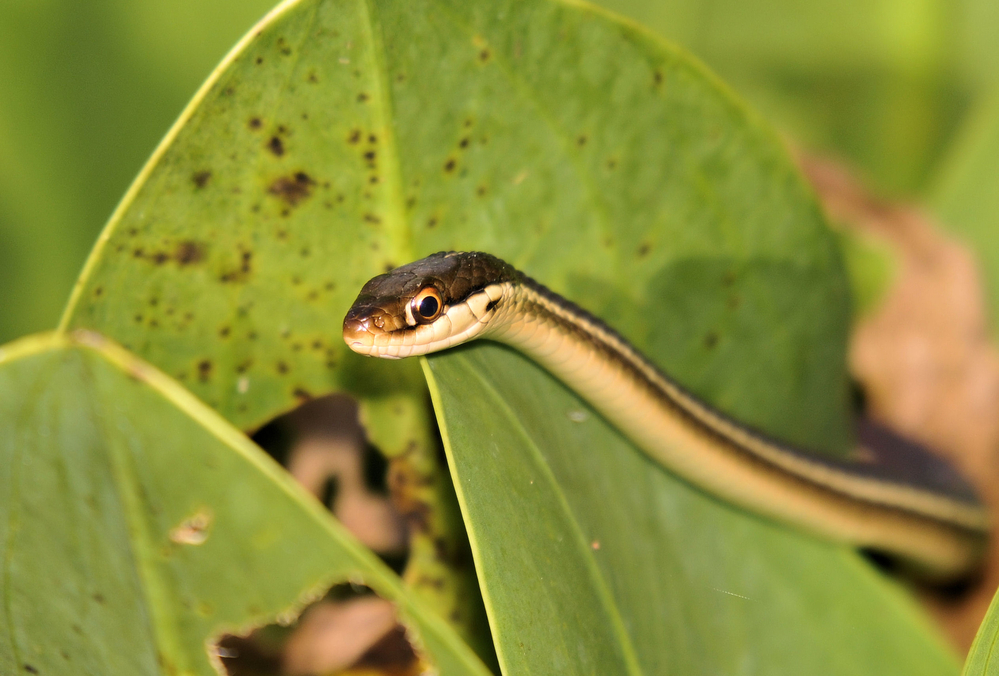
| Scientific Name: | Thamnophis proximus proximus (Western Ribbon Snake)
Thamnophis sauritus sauritus (Eastern Ribbon Snake) Thamnophis sauritus septentrionalis (Northern Ribbon Snake) |
|---|---|
| Range: | T. p. proximus: Northwest corner of Indiana
T. s. sauritus: Statewide except Southeast and East-Central regions T. s. septentrionalis: Northern ⅔ of Indiana |
| Size: | T. p. proximus: 17 – 50 in.
T. s. sauritus: 7 – 34 in. T. s. septentrionalis: 18 – 26 in. |
| Description: | Large eyes
Keeled scales Slender-bodied Base color is brown to black Bright yellow or orange dorsal stripe and one light-colored lateral stripe on each side T. p. proximus has a white spot on its head that differentiates it from the other species |
| Habitat: | Most wetland habitats |
| Venomous/Non-Venomous: | Mildly Venomous (not medically significant for humans) |
Fun Fact: Ribbon Snakes give birth to live offspring, like mammals!
Garter Snakes
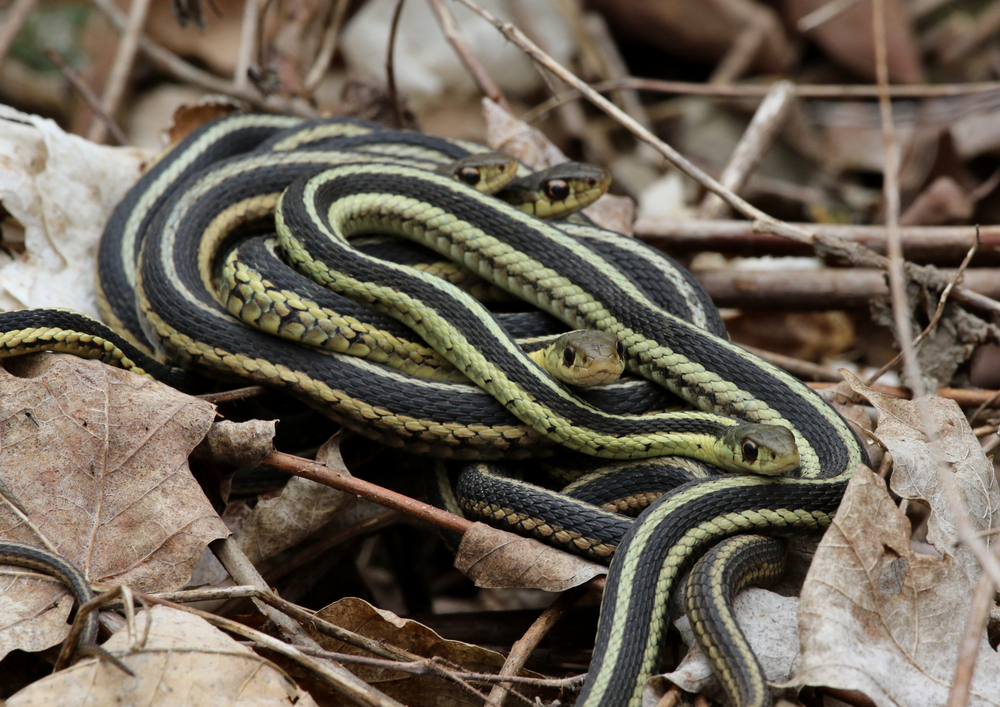
| Scientific Name: | Thamnophis radix (Plains Garter Snakes)
Thamnophis butleri (Butler’s Garter Snakes) Thamnophis sirtalis sirtalis (Eastern Garter Snakes) Thamnophis sirtalis semifasciatus (Chicago Garter Snakes) |
|---|---|
| Range: | T. radix: Northwest corner of Indiana
T. butleri: Northwest corner of Indiana T. s. sirtalis: Statewide T. s. semifasciatus: Northwest corner of Indiana |
| Size: | T. radix: 2 – 3 ft.
T. butleri: 1 – 2 ft. T. sirtalis: 2 – 4 ft. |
| Description: | Keeled scales
Base color is gray-green, brown, or black Dark labial (lip) bars that distinguish them from the ribbon snake species Light-colored dorsal stripe and lateral stripes that nearly merge with the belly T. butleri: head is smaller than other Thamnophis, and the neck is indistinct |
| Habitat: | All habitats |
| Venomous/Non-Venomous: | Mildly Venomous (not medically significant to humans) |
Gray or Black Rat Snake
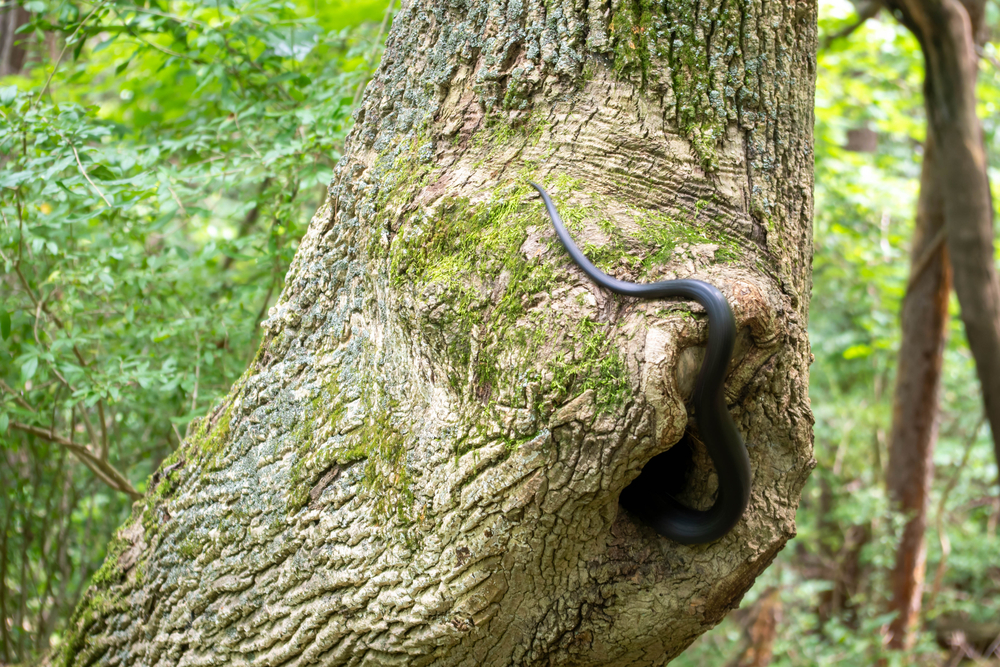
| Scientific Name: | Pantherophis spiloides |
|---|---|
| Range: | Statewide except the Northwest corner |
| Size: | 3 – 8 ft. |
| Description: | Smooth scales
Base color is light gray to black Juveniles have black bands that fade with age Most adults have some light-colored speckling along their previous juvenile pattern |
| Habitat: | Forests and agricultural buildings |
| Venomous/Non-Venomous: | Non-Venomous |
DeKay’s Brown Snakes
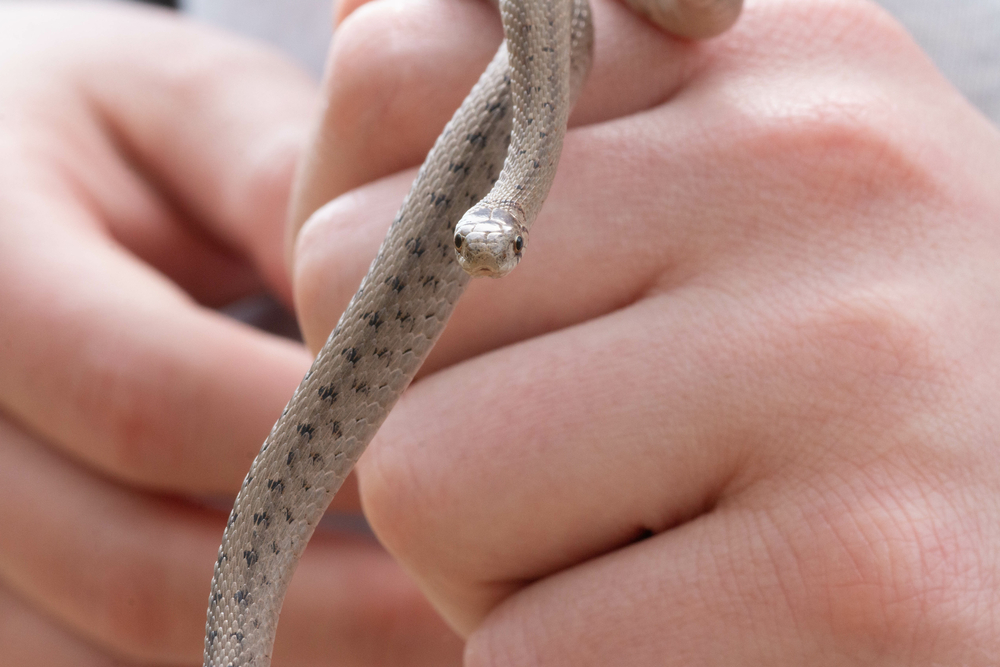
| Scientific Name: | Storeria dekayi dekayi (Northern Brown Snake)
Storeria dekayi wrightorum (Midland Brown Snake) |
|---|---|
| Range: | Statewide |
| Size: | 10 – 15 in. |
| Description: | Keeled scales
Slender-bodied Head is darker than body Base color is grayish-brown One or two dark spots beneath and behind the eyes Light-colored dorsal stripe bordered by small dark spots |
| Habitat: | Moist, open prairies and meadows |
| Venomous/Non-Venomous: | Non-Venomous |
Water Snakes in Indiana
Most people automatically assume that any snake they see in the water is a venomous Water Moccasin.
In Indiana, the reality is that Water Moccasins only live in a tiny area in the southern region of the state.
Common Water Snakes, including the Northern Water Snake and Midland Water Snake, are common throughout the entire state.
These gentle, fish-loving snakes make great pets and have won the hearts of many reptile keepers.
Common Water Snake
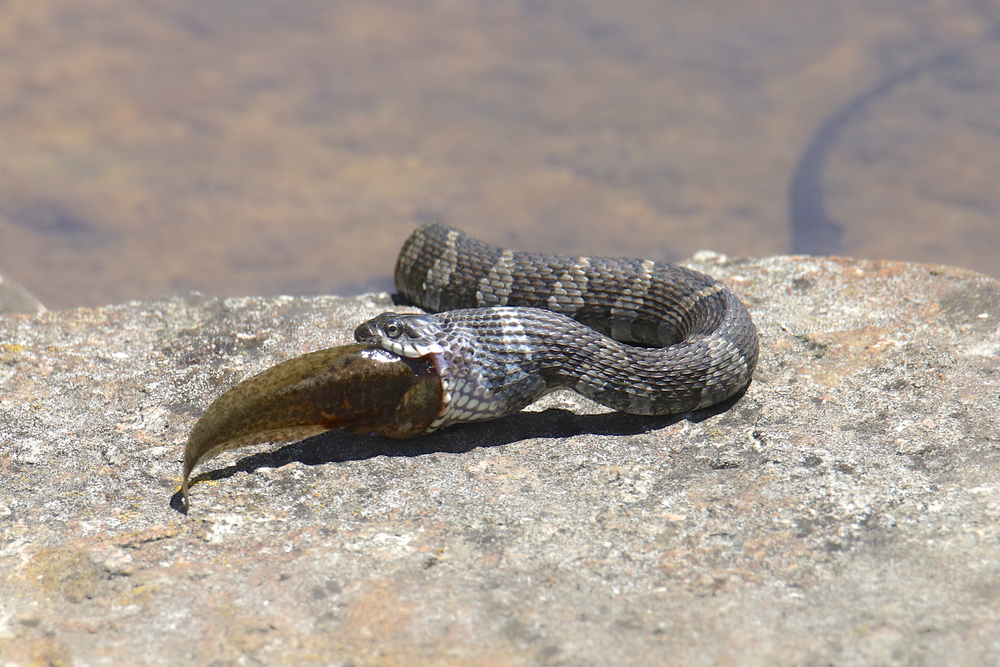
| Scientific Name: | Nerodia sipedon sipedon (Northern Water Snake)
Nerodia sipedon pleuralis (Midland Water Snake) |
|---|---|
| Range: | Statewide |
| Size: | 2 – 4 ft. |
| Description: | Heavy-bodied
Keeled scales Base color is gray or brown Black, brown, or reddish-brown bands that are widest on the back and narrow towards the belly |
| Habitat: | Along slow-flowing bodies of water |
| Venomous/Non-Venomous: | Non-Venomous |
Copperbelly Water Snake
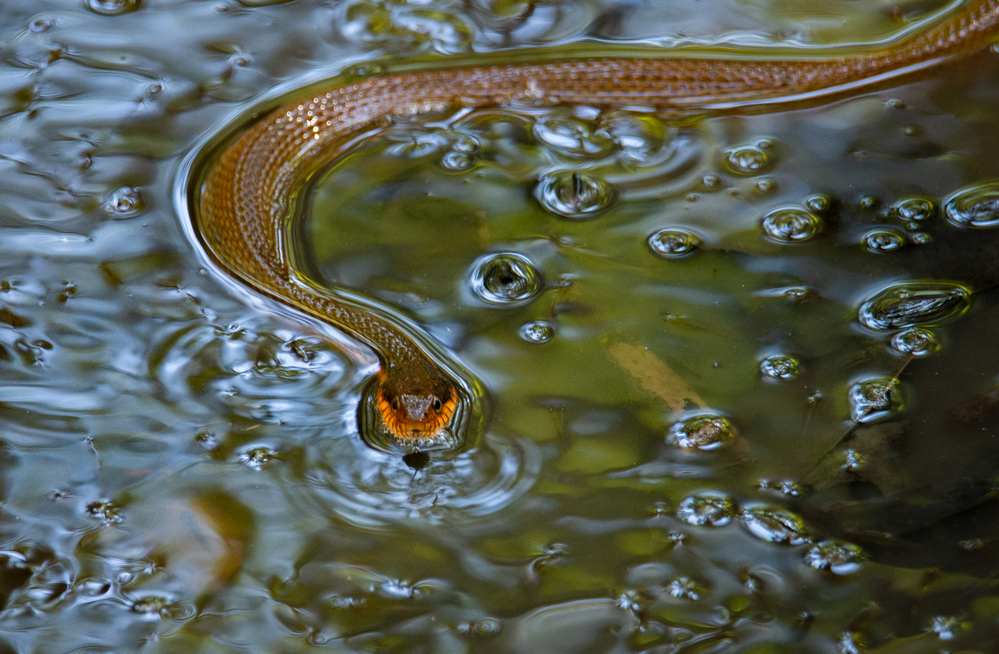
| Scientific Name: | Nerodia erythrogaster neglecta |
|---|---|
| Range: | Southwest and Northeast corners of Indiana |
| Size: | 3 – 5 ft. |
| Description: | Heavy-bodied
Keeled scales Base color is patternless jet black Bright red or copper-orange belly Juveniles are light gray or brown with dark bands and a dull belly that brightens with age |
| Habitat: | Shallow, open wetlands |
| Venomous/Non-Venomous: | Non-Venomous |
Northern Diamondback Water Snake
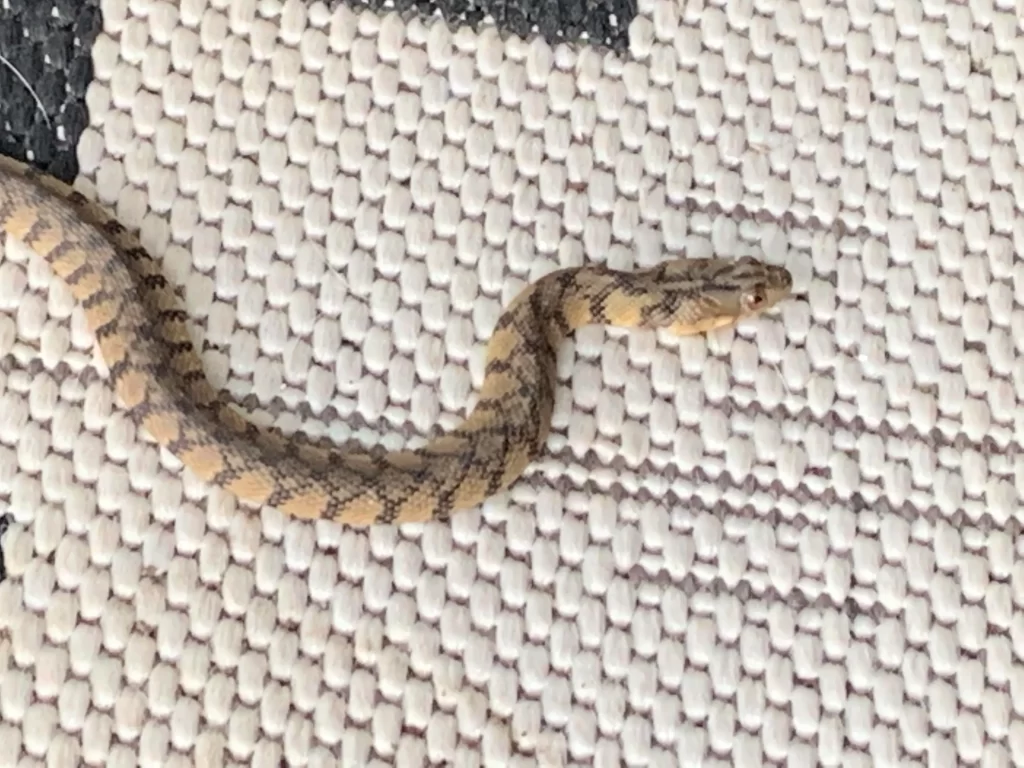
Image Credit: u/Genetics (via Reddit.com)
| Scientific Name: | Nerodia rhombifer |
|---|---|
| Range: | Southwest corner of Indiana |
| Size: | 2 – 5 ft. |
| Description: | Heavy-bodied
Keeled scales Base color is light-gray to olive-green Distinctive black chainlink diamond pattern Reddish-orange eyes positioned towards the top of the head |
| Habitat: | Most wetland habitats |
| Venomous/Non-Venomous: | Non-Venomous |
Other Native Snake Species
So far, we’ve only scratched the surface with Indiana’s water snakes, venomous snakes, and common snakes.
There are plenty more Indiana snakes to learn about, from the loud and hissy Bullsnake to the dramatic wannabe-cobra Eastern Hognose Snake.
Bullsnake
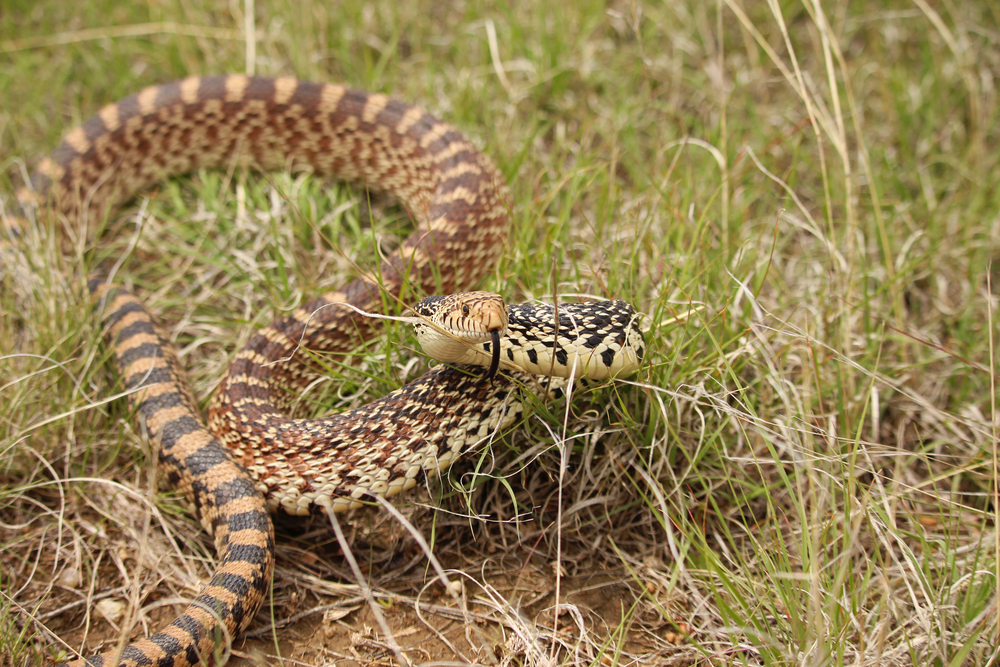
| Scientific Name: | Pituophis catenifer sayi |
|---|---|
| Range: | Northwest and Southwest corner of Indiana |
| Size: | 4 – 8 ft. |
| Description: | Keeled scales
Base color is vibrant yellow Dorsal blotches that range from brown to black and become larger and darker towards the head |
| Habitat: | Open prairie |
| Venomous/Non-Venomous: | Non-Venomous |
Queen Snake
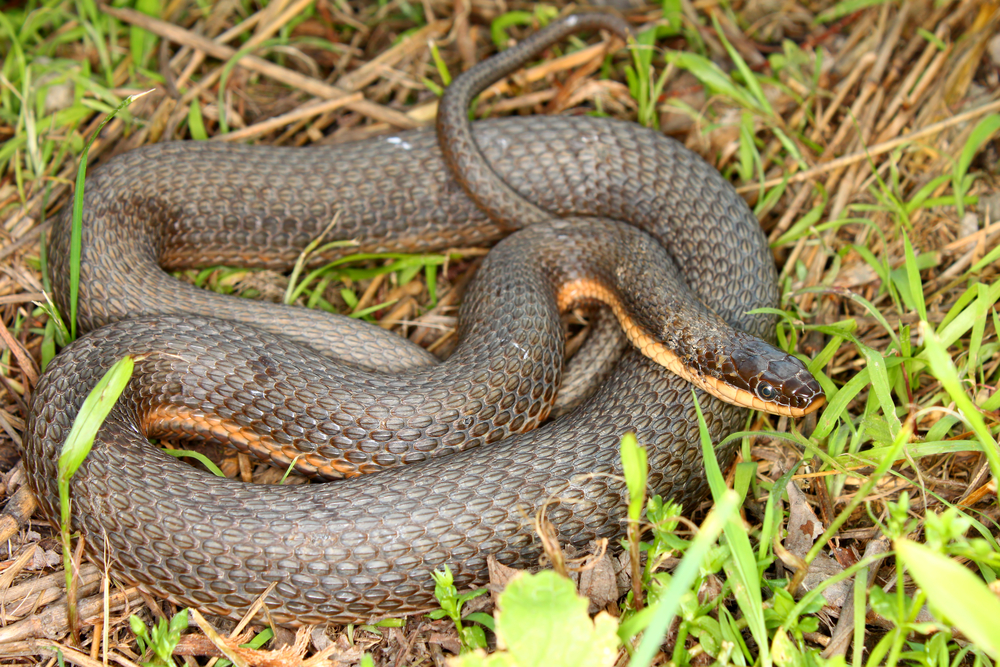
| Scientific Name: | Regina septemvittata |
|---|---|
| Range: | Statewide, except the southwest corner |
| Size: | 12 – 30 in. |
| Description: | Keeled scales
Base color is olive-brown or gray One light-colored lateral stripe on each side Juveniles have a dorsal stripe and two extra lateral stripes that fade with age Four prominent, dark-colored ventral stripes down the length of the off-white belly |
| Habitat: | Warm, shallow, rocky-bottomed streams |
| Venomous/Non-Venomous: | Non-Venomous |
Eastern Racer
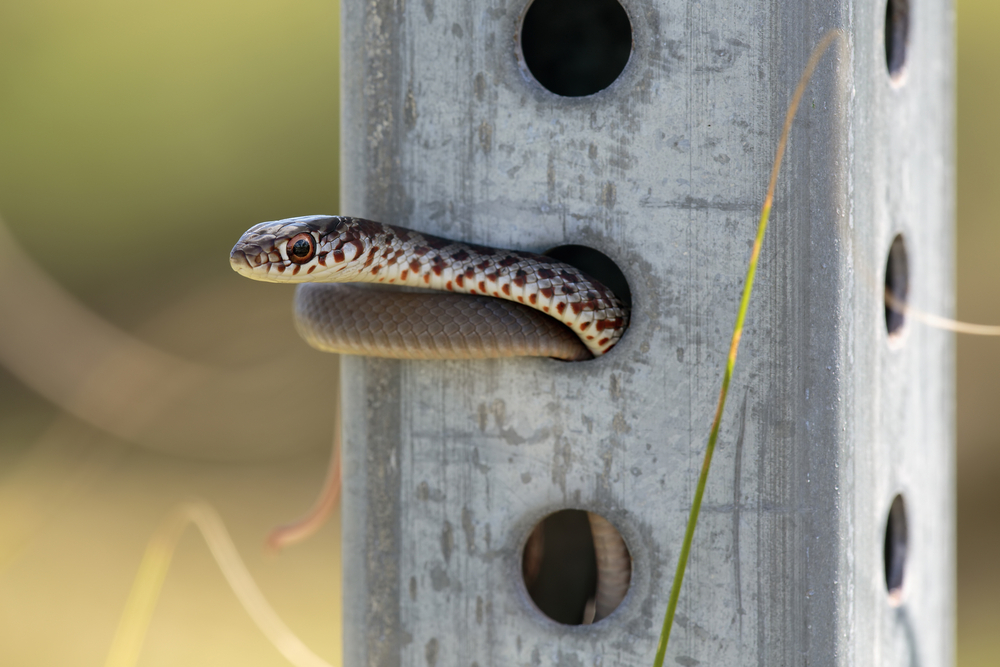
| Scientific Name: | Coluber constrictor foxii (Blue Racer)
Coluber constrictor priapus (Southern Black Racer) |
|---|---|
| Range: | C. c. foxii: Northern ¾ of Indiana
C. c. priapus: Southern ¼ of Indiana |
| Size: | C. c. foxii: 36 – 60 in.
C. c. priapus: 20 – 56 in. |
| Description: | Large eyes
Smooth scales Slender-bodied Patternless body with light-colored belly C. c. foxii: Dark gray to bluish-gray base color C. c. priapus: Dark gray to black base color Juveniles have brown blotches that fade with age |
| Habitat: | Open, grassy areas |
| Venomous/Non-Venomous: | Non-Venomous |
Kirtland’s Snake
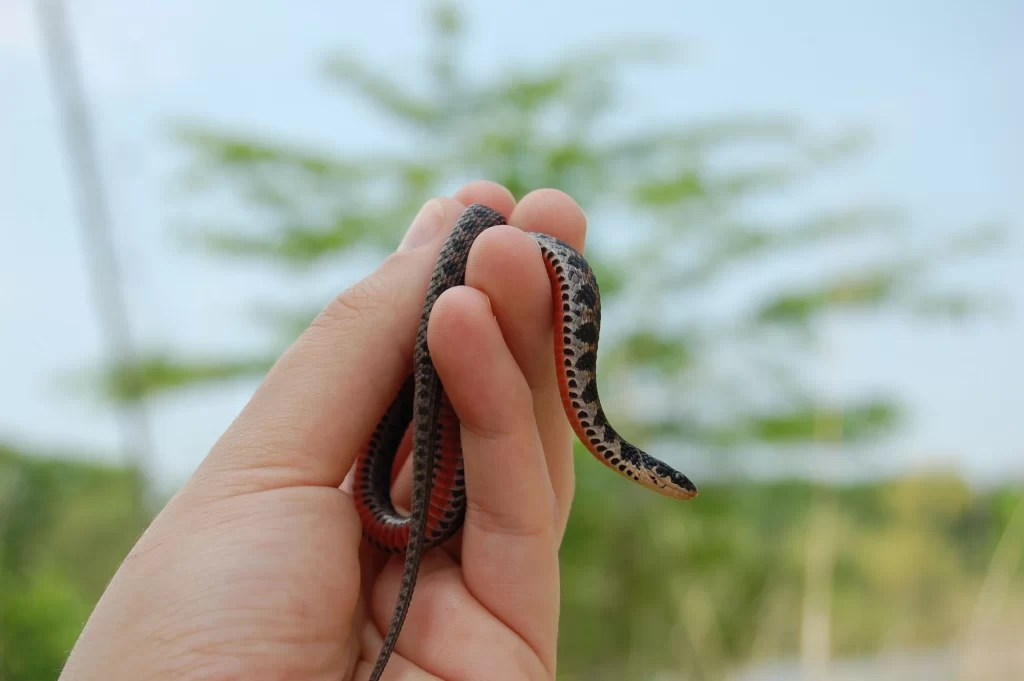
Image Credit: u/EmeraldGirl (via Reddit.com)
| Scientific Name: | Clonophis kirtlandii |
|---|---|
| Range: | Statewide |
| Size: | 12 – 18 in. |
| Description: | Keeled scales
Base color is grayish-brown Two rows of dorsal spots and one row of alternating lateral spots on each side Belly is bright pink, red, or orange, with a row of black spots along each edge |
| Habitat: | Moist, open meadows |
| Venomous/Non-Venomous: | Non-Venomous |
Prairie Kingsnake
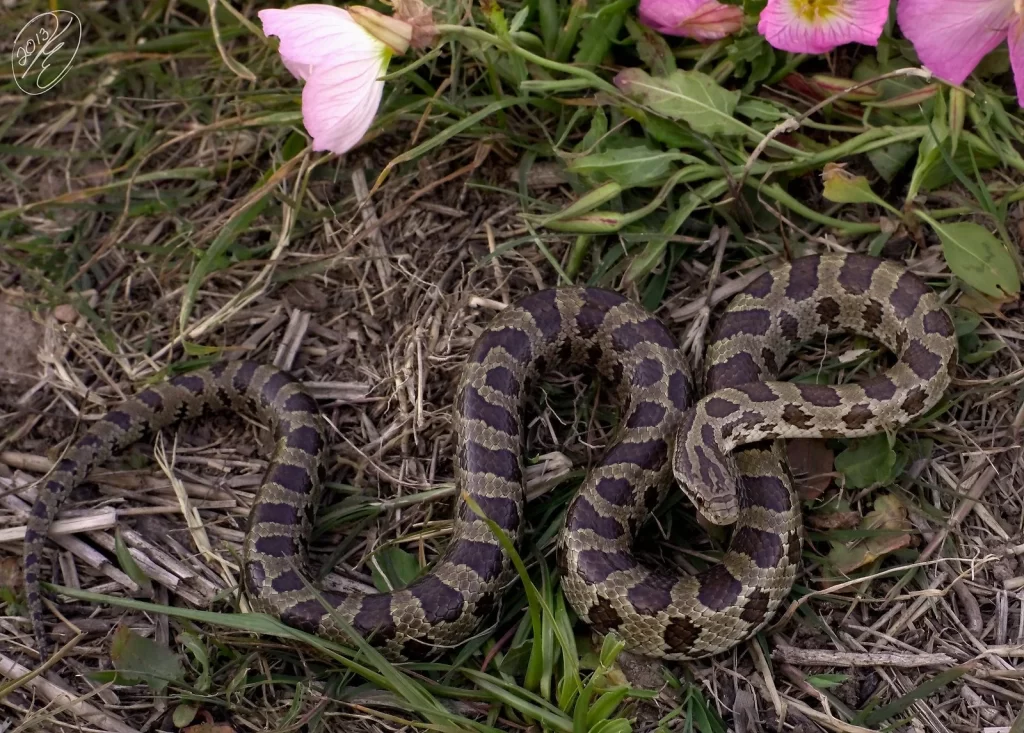
Image Credit: u/Soopaman (via Reddit.com)
| Scientific Name: | Lampropeltis calligaster |
|---|---|
| Range: | West-central region of Indiana |
| Size: | 2 – 3 ft. |
| Description: | Smooth scales
Base color is dark gray or brown Dark, reddish-brown dorsal and lateral blotches Juveniles have brightly-colored blotches that may fade or stay vibrant with age |
| Habitat: | Open, grassy habitats |
| Venomous/Non-Venomous: | Non-Venomous |
Eastern Fox Snake
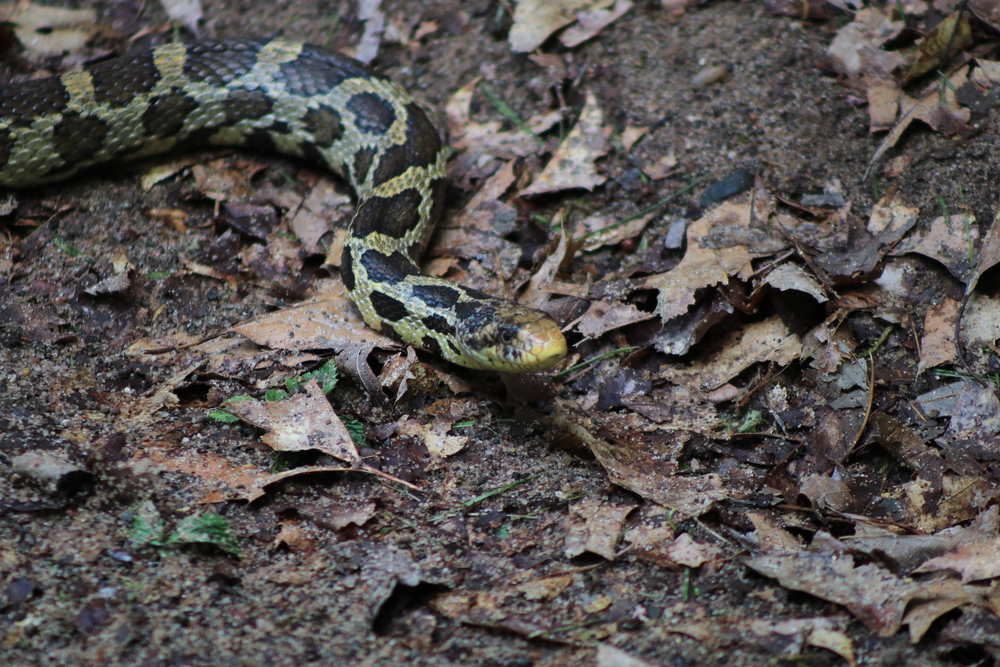
| Scientific Name: | Pantherophis vulpinus |
|---|---|
| Range: | Northwest region of Indiana |
| Size: | 3 – 6 ft. |
| Description: | Lightly keeled scales
Head may be rusty red Base color is brown, tan, or yellow Yellow checkerboard pattern on belly Dark brown dorsal and lateral blotches |
| Habitat: | Forests and open habitats |
| Venomous/Non-Venomous: | Non-Venomous |
Western Mud Snake
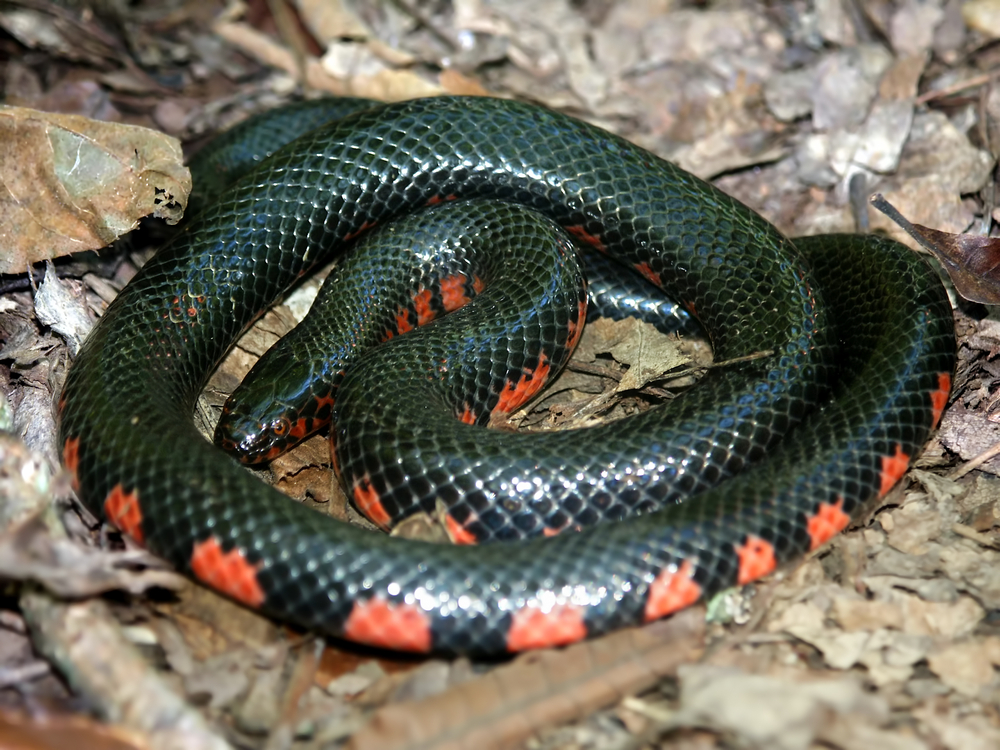
| Scientific Name: | Farancia abacura |
|---|---|
| Range: | Knox County |
| Size: | 2 – 6 ft. |
| Description: | Base color is jet black
Smooth, glossy scales Belly is striped bright red and black, with the bright red stripes extending up the snake’s sides and fading into pale pinkish-red lateral bands |
| Habitat: | Swampland |
| Venomous/Non-Venomous: | Non-Venomous |
Smooth Greensnake
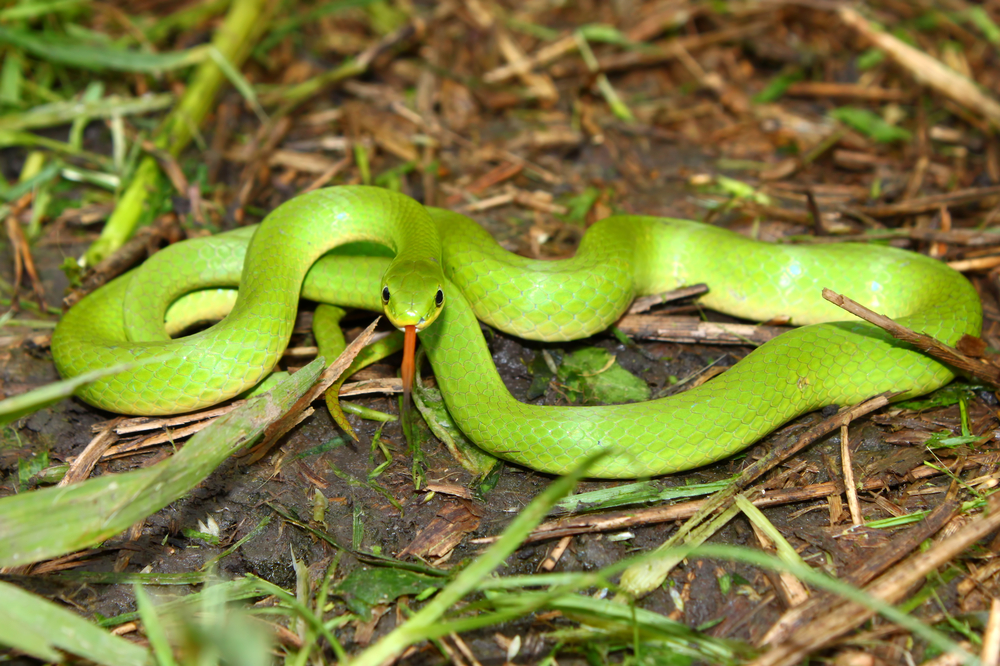
| Scientific Name: | Opheodrys vernalis |
|---|---|
| Range: | Northwest corner of Indiana |
| Size: | 14 – 20 in. |
| Description: | Smooth scales
Whitish underside Base color is vibrant green |
| Habitat: | Wet prairies |
| Venomous/Non-Venomous: | Non-Venomous |
Northern Scarlet Snake
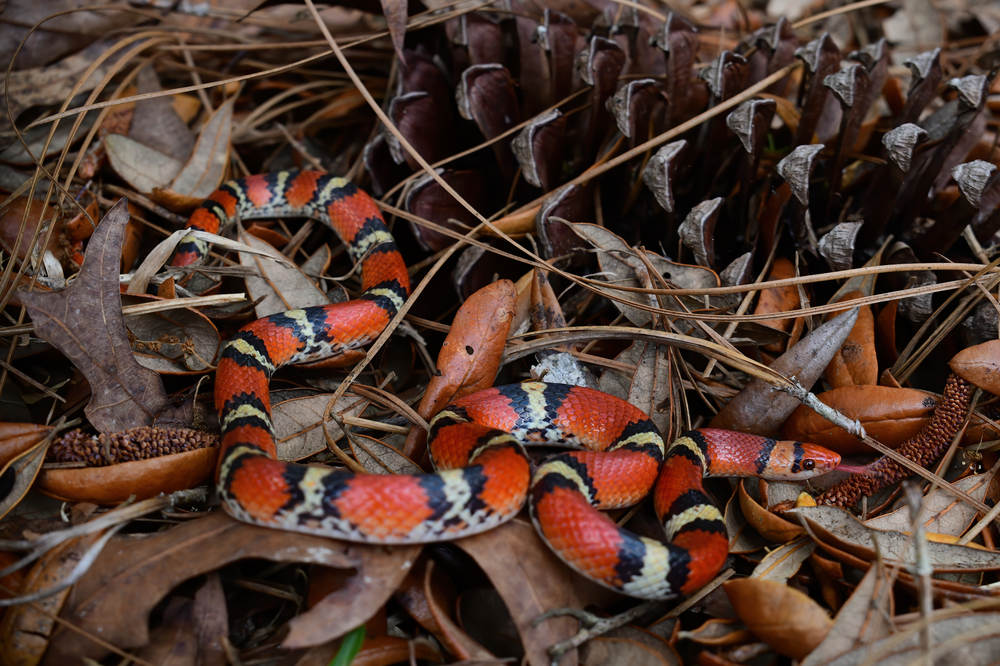
| Scientific Name: | Cemophora coccinea |
|---|---|
| Range: | Floyd County |
| Size: | Smooth scales
Base color is drab gray-brown, body is patternless |
| Description: | Pointed snout
Smooth scales Base color is whitish gray Large black-bordered, orangish-red dorsal blotches that resemble full bands but don’t extend to the underside |
| Habitat: | Open, rocky glades |
| Venomous/Non-Venomous: | Non-Venomous |
Midwestern Worm Snake
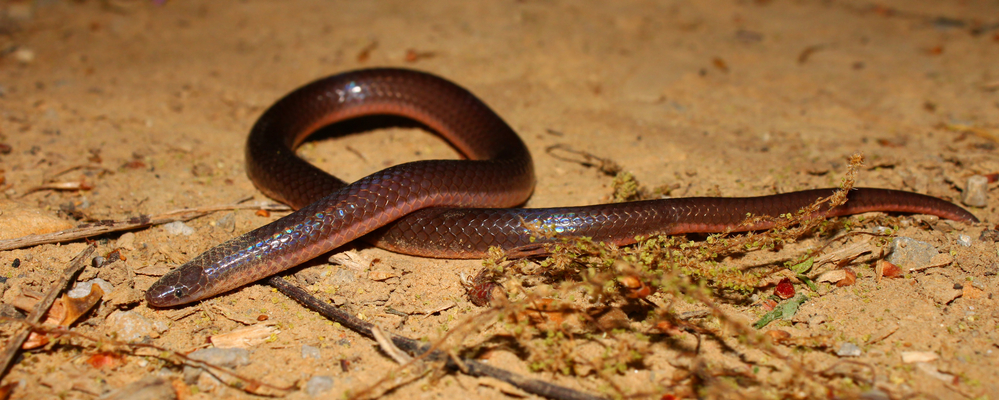
Scientific Name:
| Scientific Name: | Carphophis amoenus helenae |
|---|---|
| Range: | Southern ½ of Indiana |
| Size: | 7 – 11 in. |
| Description: | Slender-bodied
Base color is brown Smooth, glossy scales Belly is light pinkish-white |
| Habitat: | Hilly habitats |
| Venomous/Non-Venomous: | Non-Venomous |
Eastern Black Kingsnake
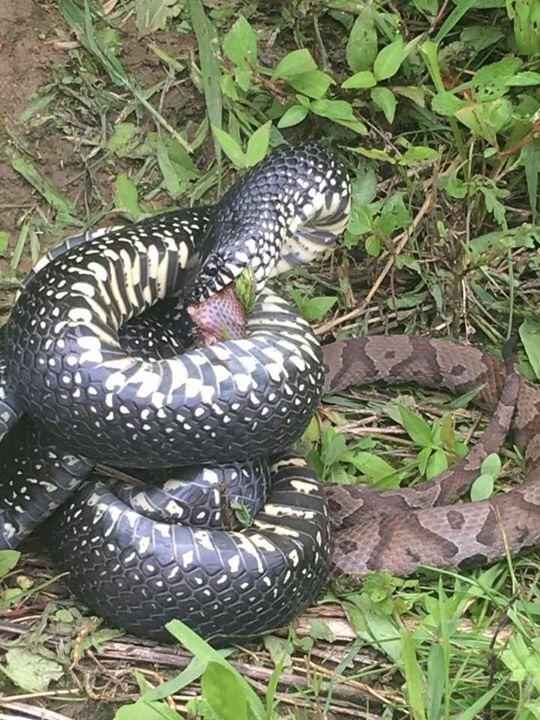
Image Credit: u/MrsTuitous (via Reddit.com)
| Scientific Name: | Lampropeltis nigra |
|---|---|
| Range: | Southern ⅓ of Indiana |
| Size: | 3 – 5 ft. |
| Description: | Base color is jet black
Smooth, glossy scales White mouth with black labial (lip) bars Juveniles have thin, light-colored bands and speckles that fade with age |
| Habitat: | Overgrown clearings |
| Venomous/Non-Venomous: | Non-Venomous |
Northern Redbelly Snake
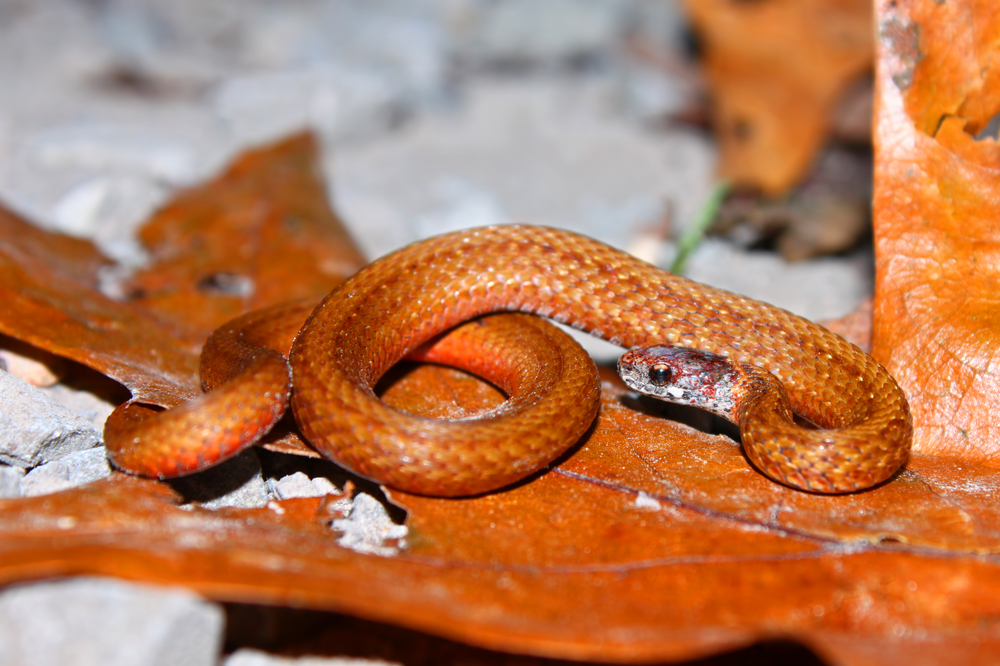
| Scientific Name: | Storeria occipitomaculata |
|---|---|
| Range: | South-central and Northern regions of Indiana |
| Size: | 10 – 12 in. |
| Description: | Keeled scales
Belly is bright orangish-red Base color is brown, gray, or black One to three light blotches behind the head Two thin, dark dorsal stripes border a stripe that may be gray or brown |
| Habitat: | Forests and open grasslands |
| Venomous/Non-Venomous: | Non-Venomous |
Eastern Hognose Snake
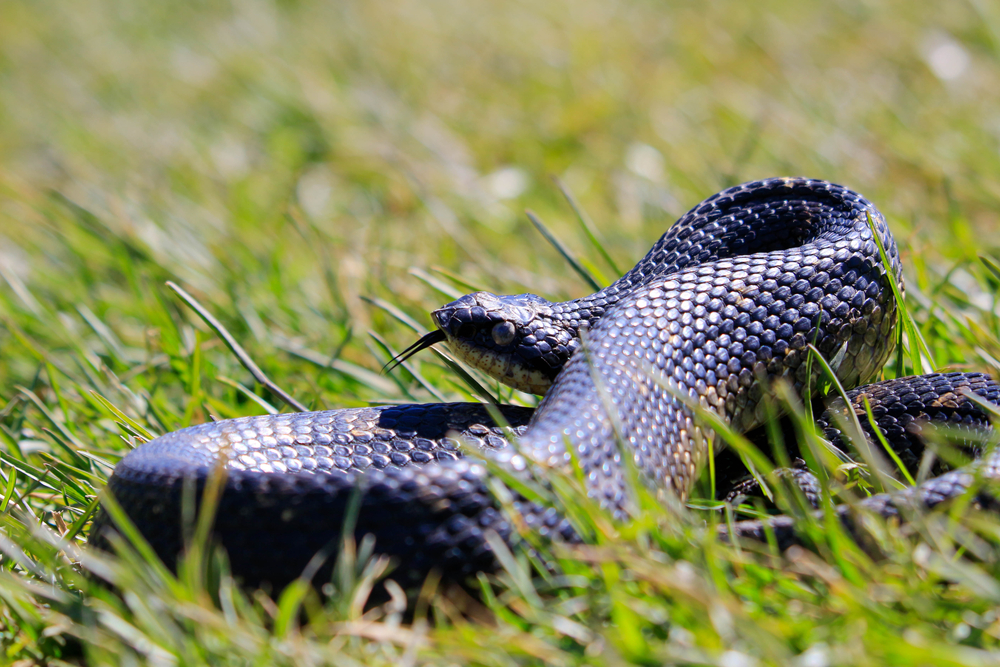
| Scientific Name: | Heterodon platirhinos |
|---|---|
| Range: | Statewide, except East-Central Indiana |
| Size: | 2 – 4 ft. |
| Description: | Keeled scales
Upturned rostral (nose) scale Base color is gray-brown to orange-yellow Dark brown irregular dorsal blotches with alternating lateral blotches Snake may flatten its neck out when it feels threatened (like a cobra) |
| Habitat: | Habitats with sandy soil |
| Venomous/Non-Venomous: | Mildly Venomous (not medically significant to humans) |
Fun Fact: Thanks to their small size and attractive appearance, Hognose Snakes make great pets.
Northern Rough Greensnake
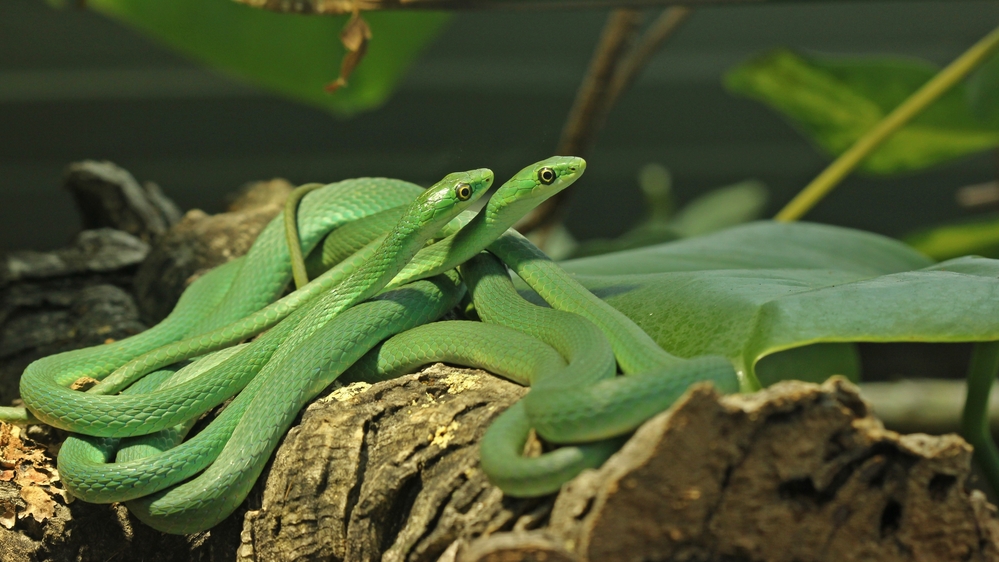
| Scientific Name: | Opheodrys aestivus aestivus |
|---|---|
| Range: | Southern ⅓ of Indiana |
| Size: | 2 – 3 ft. |
| Description: | Keeled scales
Slender-bodied Yellowish belly Base color is bright emerald green |
| Habitat: | Densely vegetated woodland edges |
| Venomous/Non-Venomous: | Non-Venomous |
Western Smooth Earthsnake
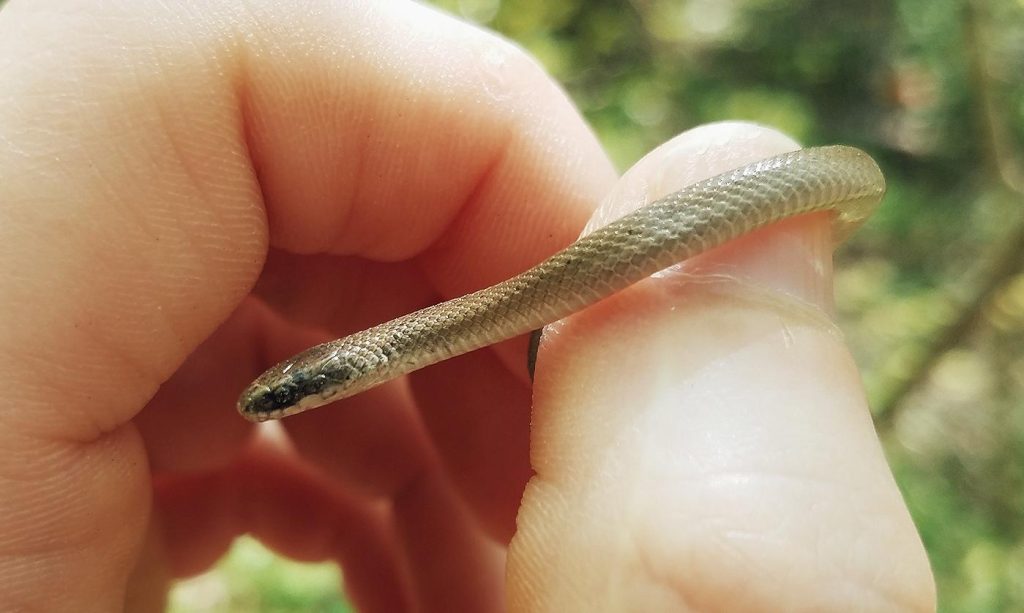
| Scientific Name: | Virginia valeriae elegans |
|---|---|
| Range: | Spotty distribution in Western Indiana |
| Size: | 7 – 12 in. |
| Description: | Smooth scales
Base color is drab gray-brown, body is patternless |
| Habitat: | Stony, hilly habitats |
| Venomous/Non-Venomous: | Non-Venomous |
Northern Ring-Necked Snake
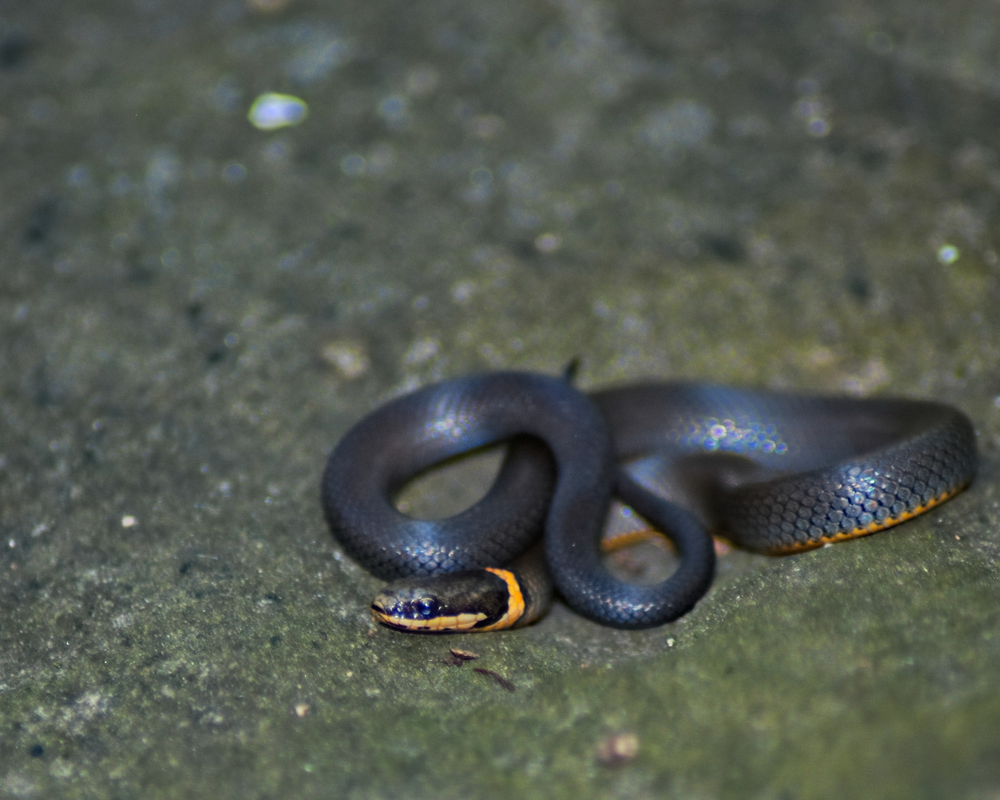
| Scientific Name: | Diadophis punctatus edwardsii |
|---|---|
| Range: | Southern ½ of Indiana |
| Size: | 10 – 15 in. |
| Description: | Smooth scales
Base color is dark gray to black Belly is bright yellow and also forms a thin ring around the neck |
| Habitat: | Woodlands |
| Venomous/Non-Venomous: | Mildly Venomous (not medically significant to humans) |
Southeastern Crowned Snake
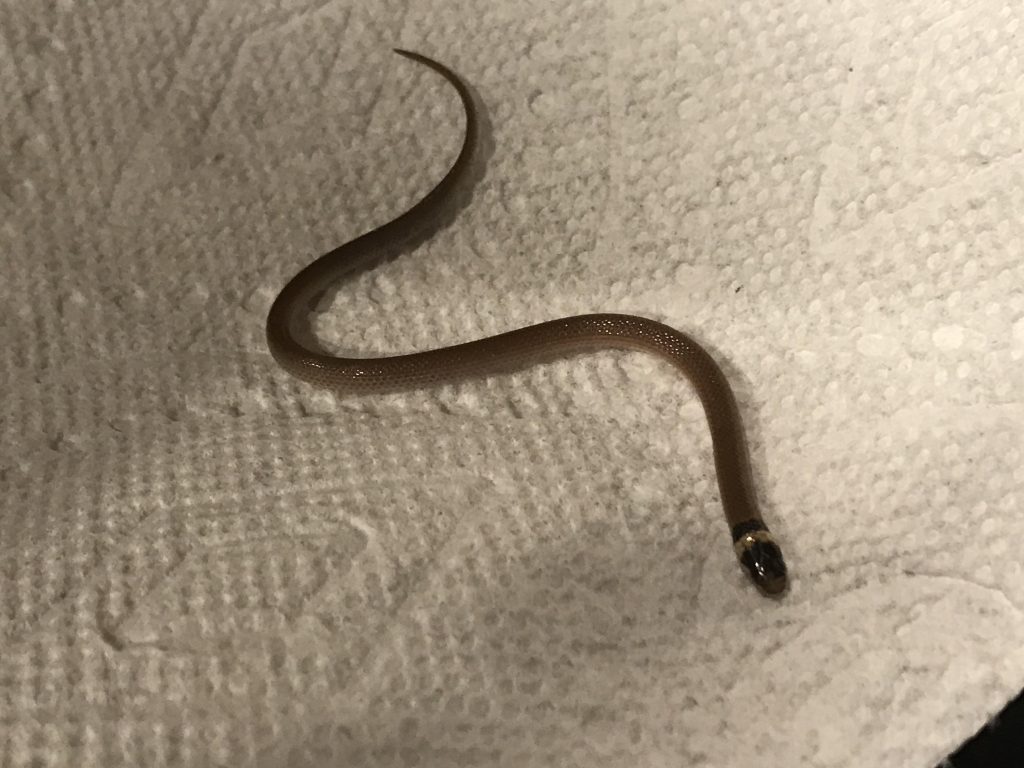
Image Credit: u/Barba_del_Lobo (via Reddit.com)
| Scientific Name: | Tantilla coronata |
|---|---|
| Range: | Floyd and Clark Counties |
| Size: | 8 – 10 in. |
| Description: | Smooth scales
Base color is light tan Black head separated from body by a single light-colored ‘crown’ around their neck (hence the name) |
| Habitat: | Rocky glades |
| Venomous/Non-Venomous: | Mildly Venomous (not medically significant to humans) |
Snakes in Southern Indiana
Southern Indiana accommodates a broad range of reptilian species thanks to its warm climate and diverse landscape.
Here are the typically-found snakes in Southern Indiana:
- Bullsnake (Pituophis catenifer sayi)
- Eastern Racer (Coluber constrictor)
- Queen Snake (Regina septemvittata)
- Kirtland’s Snake (Clonophis kirtlandii)
- Milk Snakes (Lampropeltis triangulum)
- Timber Rattlesnake (Crotalus horridus)
- Western Mud Snake (Farancia abacura)
- DeKay’s Brown Snakes (Storeria dekayi)
- Prairie Kingsnake (Lampropeltis calligaster)
- Northern Copperhead (Agkistrodon contortrix)
- Eastern Black Kingsnake (Lampropeltis nigra)
- Western Cottonmouth (Agkistrodon piscivorus)
- Northern Scarlet Snake (Cemophora coccinea)
- Eastern Hognose Snake (Heterodon platirhinos)
- Midland Water Snake (Nerodia sipedon pleuralis)
- Southeastern Crowned Snake (Tantilla coronata)
- Red Milk Snake (Lampropeltis triangulum syspila)
- Gray or Black Rat Snake (Pantherophis spiloides)
- Northern Redbelly Snake (Storeria occipitomaculata)
- Ribbon Snakes and Garter Snakes (Thamnophis spp.)
- Western Smooth Earthsnake (Virginia valeriae elegans)
- Eastern Milk Snake (Lampropeltis triangulum triangulum)
- Midwestern Worm Snake (Carphophis amoenus helenae)
- Northern Diamondback Water Snake (Nerodia rhombifer)
- Copperbelly Water Snake (Nerodia erythrogaster neglecta)
- Northern Rough Greensnake (Opheodrys aestivus aestivus)
- Northern Ring-Necked Snake (Diadophis punctatus edwardsii)
Snakes in Northern Indiana
While Northern Indiana may not boast the level of species diversity that the lower half of the state does, the snakes that do survive in Northern Indiana are prime examples of resilience and adaptability in reptiles.
Many of these cold-tolerant species also inhabit Michigan.
- Bullsnake (Pituophis catenifer sayi)
- Eastern Racer (Coluber constrictor)
- Queen Snake (Regina septemvittata)
- Kirtland’s Snake (Clonophis kirtlandii)
- DeKay’s Brown Snakes (Storeria dekayi)
- Smooth Greensnake (Opheodrys vernalis)
- Eastern Foxsnake (Pantherophis vulpinus)
- Prairie Kingsnake (Lampropeltis calligaster)
- Eastern Hognose Snake (Heterodon platirhinos)
- Northern Water Snake (Nerodia sipedon sipedon)
- Gray or Black Rat Snake (Pantherophis spiloides)
- Northern Redbelly Snake (Storeria occipitomaculata)
- Ribbon Snakes and Garter Snakes (Thamnophis spp.)
- Western Smooth Earthsnake (Virginia valeriae elegans)
- Eastern Massasauga Rattlesnake (Sistrurus catenatus)
- Eastern Milk Snake (Lampropeltis triangulum triangulum)
- Copperbelly Water Snake (Nerodia erythrogaster neglecta)
- Northern Ring-Necked Snake (Diadophis punctatus edwardsii)
What You Need to Know
No matter how scary you might think snakes are, in reality, snakes (even venomous ones) see larger beings – like us humans – as potential predators.
Most snakes would rather flee or hide than fight.
Coexisting with Indiana Snakes
Snakes play a vital role in Indiana’s natural ecosystem.
Predators, including birds of prey, foxes, and raccoons, rely on snakes as a source of food, which also controls pest populations.
Greensnakes will eat pest insects, like locusts.
Kingsnakes will eat other snakes, including venomous ones.
Rat Snakes in Indiana, as their name suggests, can clear rodents from a property.
Even tiny DeKay’s Brown Snakes and Earthsnakes eat garden pests, like slugs.
Snake Safety 101
The most important piece of snake safety advice I can offer is to leave snakes alone.
If you see a venomous serpent on a trail or your property, leave it alone, and it will eventually move on. Snakes don’t want anything to do with people.
About Venomous Snakes
Venomous pit viper bites in Indiana aren’t all that bad compared to other areas in the world.
Your chances of surviving a bite from any of Indiana’s species are pretty high, as long as you seek treatment at the nearest emergency room.
Further complicating matters, some harmless species, like the Eastern Garter Snake, are mildly venomous. Their specialized saliva only affects their intended prey; not humans or pets.
Treading Carefully in Snake Habitat
- Use a walking stick
- Watch where you step
- Wear sturdy shoes and long pants
- Keep your pets close and on a leash
- Stay on designated paths without overgrown vegetation
- Teach your children to follow these snake safety tips in wilderness areas
- Be cautious of where you put your hands and don’t reach where you can’t see
If You Encounter a Snake
- Do not disturb the snake!
- Freeze and assess the snake’s precise location or direction of travel
- Back up and put at least five feet of distance between you and the snake
- Turn back or travel around the snake, maintaining the five-foot distance
Expert Tip: If you find a nest of snake eggs, the best thing to do is leave them alone. Disturbing them can kill the developing offspring, and might be illegal where you live.
When to Call for Help
The answer is quite simple: you only need to call for help if you’re bitten by a venomous snake, if you’re trapped somewhere with a venomous snake, or if an injured snake needs help.
Useful Resources
Educational Resources
Midwest Partners in Amphibian and Reptile Conservation
Indiana Department of Natural Resources Snake Information Page
Indiana Herp Atlas
Hoosier Herpetological Society
Our turtle identification guide, which includes many turtles native to Indiana
Snake Relocation Services
Free Snake Relocation Directory on Facebook
Emergency Envenomation Advice
Indiana Poison Control Center: (800)222-1222
Indiana Poison Control Center – Emergencies: (317)962-2335
American Society for the Prevention of Cruelty to Animals (ASPCA) Animal Poison Control Center: 1-888-426-4435
Related Species and Articles to Indiana Snakes
If you’re interested in identifying wild reptiles, have a look at:
- Pennsylvania Snakes Identification Guide: All Species & Pics
- Tennessee Snakes Species Guide (Pics, Safety Tips, & More!)
- Missouri Snakes Identification Guide (With Tips to Staying Safe)
You can also check out our other reptile ID guides – carefully written by our experienced experts!
Have you ever seen a wild snake in Indiana? Were you able to use our guide to identify the species? Tell us about your exciting experience in the comment section, below.
